Each gardener, amateur or older, is trying to create perfect landscape design by all their might. It is enough to choose several central elements and your site will play with new paints. It is best to use natural plantings that perfectly fit into any composition and fill the garden smells of nature. In this case, all gardeners are recommended to acquire the North American guest, which perfectly arrived in our territory.
It is popular and its spherical shape - compact and miniature varieties can grow even in small areas of the Earth. Thuja spherical, landing and care for which is practically not much difficult, will delight you with green beauty throughout the year and distribute the garden with a pleasant flavor of freshness.
In this article, we consider the features and description of the Tui, as well as we will give the main characteristics of the types and varieties of the Tui spheroid. We note important nuances of planting and care for this plant.
Features and description of the Tui Charovid
Thuja is an evergreen plant that belongs to the big kind of gone coniferous trees and is a representative of the family of cypress. Together with the Thuy, this family includes plants such as juniper, cypress, cypressovik, sequoia. Thuja spherical is a type of Tui, therefore also refers to this family, only to the dwarf forms. This evergreen plant is not a natural inhabitant of our climatic belt. In nature, the dwarf spherical thuja occurs only in North America and in some areas of East Asia. Tui spherical shape were delivered to Europe from these places, after which they were widespread over all European countries and in Russia.
Thuja has the Latin name Thuja, the value of which carries ancient Greek roots. Translated, it means "sacrifice", "anonymous". This is primarily due to the smell that exudes the aromatic rocks of the Tui during ritual combustion, which was universally distributed in those distant years. Even now, the modern varieties of the Tui spheroid spread throughout the plot of a pleasant coniferous aroma, for which this evergreen plant is valued by gardeners.
Thuja spherical has long become a favorite plant among owners of their own sections, since this evergreen beauty fits perfectly into any landscape composition and does not require special efforts and knowledge when landing and care. Therefore, you can say. That Thuja spherical in the garden is one of the most beautiful and at the same time simple and indispensable plants.
Description Tui Character:
- Like the whole genus, the Thuja Scharovo belongs to the family of cypress and is an evergreen coniferous plant.
- All the varieties of Tui Western Schora differ in very slow growth, so they live in one place for a very long time. Some individual plants can grow to 150 years in one place, which will not be allowed to think about a constant transplantation.
- In the height, individual trees of Tui spherical can reach 50 cm, and only 2-2.5 m, which allows you to plant them near the house and not be afraid that over time, these evergreen beauties will grow strongly.
- Tui of this species have a beautiful and symmetrical ball shape, which allows this plant chic on any garden composition and facilitates the process of tree trimming.
- The needles of a young ball blower is very soft and needle, but with age becomes more rigid and scratched. In length, one chevying reaches 7 cm.
- On the color of the needles of the Tui light green or dark green, it all depends on the specific grade of the plant. There are varieties with yellow-green cheese or even a buroy.
- The plants on the plant keeps about 3 years, after which it falls.
- Already in the first year after landing on Tuya, the flags can ripen fruits, which are oval or oblong seed boxes with small flat seeds. During the ripening period, they are green, and then become brown.
- Each scaway is two seeds.
- Thuja spherical is distinguished by its unpretentiousness, which is why this evergreen plant was so good in our gardens. All types of ball-resistant ball-resistant, frost-resistant, smoke-resistant and shadowish. Therefore, in the territory of Russia, to grow such a plant will not be much difficult.
- This type of plant perfectly tolerates the ranked air of the city, so it is great for landscaping urban streets.
Variety of grades of Tui row, their characteristics
The dwarf spherical thuja has decorative features that are valued by all gardeners. You can easily pick up the Tui Schorah's grade, which will have perfect for your site with sizes and coloring needles. Consider the most popular decorative varieties of the Tui, who found their use in the gardens of Russia.
Thuja Scharovid Danika
- This species of the spherical Tui is the most popular, since from the whole manifold has the most small size.
- In the height of the Thuja Schora Danik can reach only 50-60 cm, therefore is an ideal candidate for landing in rockers and on the Alpine slide.
- Thuja Danika is a representative of the species of Western Tuy, which has excellent frost resistance and can tolerate frost to -40 degrees.
- This evergreen beauty boasts a green soft cheese throughout the year, which is simply indispensable in the autumn-winter period, when the garden is filled with dim and gray paints.
- The Croon of Tui Datika has a symmetric spherical crown, very dense, which requires constant trimming.
- Sutting off the car's seedlings of the ball dynamic, it is necessary to take into account that its root system spreads horizontally.
Thuja Scharovid Golden Gloss
- Thuja Schora Golden Globa is a low-spirited coniferous shrub.
- This kind of evergreen plants is different. In the fall of the needles, the handsome copper shade acquires, in the spring - bright golden, and in the summer yellow-green.
- Thuja Golden Gloss is also different not high growth. Maximum can reach 120 cm, in the width of Krone, it also grows by about 100-120 cm.
- It grows this kind of extremely slowly, per year you can see the growth of only 10 cm.
- Thuja rigid golden glue and good resistance to severe frosts can withstand a decrease in temperature in winter to -35 degrees.
- Thanks to the thick and compact forms of the crown, you will not get to constantly trim, seeking ideal outlines.
- This form of the Tui does not tolerate dry air, so it is better to plant it in a small shade.
- Great to growing on terraces in pots, as well as on the Alpine slides and in rockers.
Thuja Scharovoid Globes
- This species of the spherical Tui became afficient for everyone else. Thuja Globa was obtained in 1874 from the Brabant variety. In this connection, it became the first and largest ball shape of the Tui from all numerous representation.
- Different with a rounded form, the needles of which are directed up.
- In height, this evergreen plant can grow up to 2 meters. Krone can grow to 1.5-2 m.
- Thuja globa is also growing very slowly, like many shape of dwarf plants. Per year can grow only by 15-20 cm.
- Do not be afraid if you see that in the first years, Thuja resembles an oval column. After some time, Krone will acquire a spherical shape.
- The needles of a light green thuly, one, of the autumn, it acquires a grayish and brown shade.
- Perfect frost to -35 degrees.
- A couple of times for the season it will require you to pruning, which give a more neat crown shape.
- It looks great as a living bleed and as a single plant against the background of lawn. You can plant in separate garden compositions.
Tuya Charov Tinni Tim
- It is a dwarf evergreen shrub with a symmetric spherical crown.
- The needles grows fairly freely, has a light green shade.
- The needles is flat feathers covered with scales.
- Thuja Character Tinni Tim grows very slowly, by 10 years can reach a height of only 30 cm.
- An adult plant of this variety in height can maximize 1 meter, and to grow to 1-1.5 m wide.
- For the full growth of Thuya Character Tinni Tim requires constant light.
- Well tolerates large frosts, as well as arid periods.
- Perfect for landing on roller rockers and solitary landing.
Thuja Scharovid Teddy
- Thuja Character Taddy is a new variety that in a short time has become very popular among gardeners and landscape designers.
- It is a dwarf coniferous shrub that resembles a tight pillow.
- The shoots of the plant are very thin, close to each other.
- This variety is characterized by very slow growth. For the year, the bush can grow only by 2-3 cm.
- In the height, an adult plant of the Tui Charov Taddy can reach 50 cm.
- Needle needles, pretty soft. Its color varies depending on the season: in summer and in the spring it is dark green, and in winter it becomes a drone.
- Perfectly suffer severe frosts, but may suffer from dry air and direct sunlight.
Thuja Character Miriam
- Decorative coniferous evergreen plant with rounded crown form.
- This is a fairly new grade of the Tui spherical, which was derived by mutation of the Danik's variety.
- This is a dwarf plant, which can reach only 80 cm in height.
- The plant's needles are thin enough, but it is tight to each other, which allows you to have such a beautiful compact crown.
- The color of the needles is yellow-green, in winter it becomes an orange-green with a bronze tint.
- It grows slowly, per year can grow only by 5-10 cm.
The reproduction of Tui Character: the most common ways
Thuja spherical is a very popular plant in the gardens, so it is so important to know all the methods of reproduction of this evergreen beauty. Independently you can distribute a sharp seed, stalling and the division of the bush. Owning the technique of breeding, you can easily grow a whole living fence from this beautiful plant.
Seed reproduction of Tui Scharovoid
- This method of reproduction is used extremely rare, as it is quite long and ultimately you can get not exactly what you expect.
- Semyon reproduction use breeders to remove new varieties, and at home can only be seeded with seeds. When landing, for example, the Tui of the Character Danika, you can get a completely unpredictable crown shape and the color of the needles.
- However, with this method, you definitely get more enduring seedlings.
- When landing the Tui seeds, you will get young seedlings only after 3-4 years.
- First of all, it is necessary to assemble the seeds of the Tui spheroid. For this, it is important to wait until the plant's fruits mature, after which they are broken and transferred to the warm dry room.
- After about 3 days, the bumps will be revealed and it will be possible to get seeds.
- Before placing seeds into the soil, they need to soak them at 12 o'clock in water.
- It is further important to conduct a stratification process that will allow seeds faster to germinate. For this, the wet seeds are placed in the sand, moisturize it and put the tank in the refrigerator until spring.
- In the spring you can start cropping the seeds of the Tui ball.
- It is necessary to plant in open ground in advance prepared beds. In this case, the depth of the sealing should not exceed 0.5 cm.
- After planting, crops are watered and mulched sawdust.
- It is important to cover the beds with shields from the sun.
- For the first season, the seedlings spare at about 7-8 cm, and by the third spring, 50 cm can reach. It is at this time that you can transplant young saplings of Tui Scharovoy to a permanent place.
- With this method, you can get half a seedlings with a colonum-shaped crown, and half with spherical.
Splitting Tui Schora Sharoving
- This method is the most acceptable for the reproduction of the Tui spheroid, as it does not take much time and does not require a large amount of work.
- First of all, it is necessary to prepare cuttings as a planting material. It is recommended to do this in July or August.
- Choose on an adult bush. Warm down 30-40 cm long shoots or young shoots of this year 15-20 cm long.
- It is impossible to cut the cuttings, they must be separated along with the heel. Thus, the cuttings will be better suited.
- Further, all the cuttings at the bottom must be cleaned from the needles, after which it is recommended to lower them for several hours into the solution of the corpering or other rooting agent.
- At this time, it is necessary to prepare an excavation mixture in the greenhouse, in which the cuttings will land. To do this, take the equal parts of the turf, peat and sand and well all sway with a weak solution of manganese.
- Next, the cuttings are planted on a depth of 2-3 cm, and the landing themselves are well covered with a film.
- During the rooting of the cuttings, it is important to constantly maintain high humidity. To do this, it is recommended that the soil does not water, and to span water.
- It is also important to constantly venture landing.
- In the fall, all the cuttings must be covered with a film and a sweetheart.
Preparation before landing Tui ball in the garden
In order to get a beautiful and well-groomed evergreen plant of the Tui, it is important to carefully prepare before landing. And at least the shrub itself is not picky and can grow anywhere, it is important to create for it the most acceptable growth conditions for it. First of all, it is important to purchase healthy and high-quality seedlings of the Tui Scharovo-free variety you, as well as pick up on our site the most suitable place for landing.
Stage 1. Selection of varieties and seedlings of Tui Schora
- From the proper seedlings of the Tui spherical, the speed of growth and the future appearance of the plant will depend on the seed.
- It is important to acquire seedlings only in specialized nurseries or garden centers, which are professionally engaged in growing different plants.
- You can buy seedlings in the spring and autumn. Although many gardeners recommend planting plants in spring time.
- It is important to acquire seedlings only in containers with a closed root system, since with open roots you risk acquiring a non-visual plant.
- When choosing a grade of the Tui ball, focus on the size of the site where you are going to plant plants. However, in any case, all varieties are characterized by compact sizes.
- Also be sure to buy seedlings that have already reached 7-9 years of age. Younger plants can long and badly catch up.
- Before buying plants, be sure to check the appearance. There should be no visible damage and dry sections on the needles. There should also be no signs of various diseases and pests. Soil in the container should also have a well-kept view.
Stage 2. Selection of a place for landing Tui Schora
- It is also important to find an optimal place to land the car's saplings.
- All varieties of this plant prefer an open and spacious place where there is no large number of plantings.
- It is also important that evergreen beauties receive a sufficient amount of sunlight, but the open sun is harmful for them throughout the day. The needles can burn out.
- Suitable for the Tui and a small shadow, but do not land in full shadow. This may lead to the fact that the needles will become dim and growing plants will slow down.
- Stormy drafts and strong winds are categorically removed, so it is important to plant seedlings in a secure place.
- The landing site should be selected depending on the planned garden composition. For this plant, rocaria, alpine slides, lawns and places along the borders and garden tracks are perfectly suitable for this plant.
Stage 3. Choosing and soil preparation for landing Tui Schora
- Saplings of the Tui Charovid do not wear a long stagnation of water in the ground, so it is important to prepare a good drainage.
- All Tui varieties prefer to grow on fertile soils, if the ground you have poor, you can add a little complex mineral fertilizer.
- Prepare a landing space need in advance. To do this, carefully dig a selected place, about 1 bayonet shovel, well burst and scatter.
- For about 2 weeks, it is important to dig a pit for planting a saplings of Tui Schora.
Tui Schora Tui Technology
- It is best to land the Tui ball in spring, so the plant will have time to take care of the onset of frosts.
- 2 weeks before the landing time carefully prepare the selected place and dig up the landing holes.
- The sizes of the pits will depend on the specific Tui variety and on the size of the root system. On average, the depth of the pit should be approximately 60-80 cm.
- If you sit down several plants nearby, it is important to observe the optimal distance between them. It must be at least 1 meter, since the root system of plants grows in a horizontal direction.
- Drop the pits and the resulting soil must be mixed in equal proportions with a delicate soil, sand and peat. You can add some fertilizers here.
- If the plot is in lowland or in the soil, clay prevails, it is important to make a good drainage. Gravel, broken brick or small stones are perfect as a drainage. The layer of such a drainage should be about 20 cm.
- Before boarding abundantly, paint the soil in a pot with a sapling and carefully remove the plants, try not to damage the roots.
- Place the seedlings in the landing pits in such a way that the root neck is on the same level with the soil.
- Put the soaps of the soil and lose weight slightly, after which it is well water.
Agrotechnics of growing Tui Charov: Secrets and Nuances of Care
Tui spherical in care are very not demanding, but some nuances still need to know. This will continue to provide the plant optimal conditions for growth and development.
Watering Tui Schrovoid
To facilitate the process of irrigation around the seedlings, it is important to make peculiar wells, with the help of which moisture will come directly to the roots. Immediately after landing, you should water young plants once a week. However, during dry days, it is recommended to increase the amount of watering twice. On average, one plant should have approximately one bucket of water, it may take up to 20 liters to 20 liters.
Looping and mulching of the thuja row
Immediately after irrigations, it is important to loosen the soil around the plants in order to increase the access of oxygen to the roots. However, it is necessary to loosen very carefully, since the root system is very close to the surface and you can damage it. Also, to prevent excessive evaporation of moisture, it is recommended to use a layer of mulch. The mulch can be used peat.
Fucking Tui Schrovoid
It is necessary to begin to feed the young plants of the Tui spherical plants only from the second year of life. Feed the plants in the spring. To do this, use complex mineral fertilizers at the rate of 50-60 grams per square meter.
Trimming Tui Charovid
Trimming the spherical Tui is an important step of care for this plant. All varieties of this type of thuu have a symmetric and compact crown, which reacts perfectly on trimming. There are no specific framework rates. However, it is best to do this in the spring until the moment of laying the kidney. Single plants need sanitary and thinning trimming, and plants from living hedges require forming cropping. To form a crown plant is important to start only when it has reached a certain age. Remember that some varieties demand to do crop twice a year, while it is recommended to cut no more than one third of the escape.
Wintering Tui Schrovoid
Young plants need shelter for the winter. To do this, they are covered with a sweetheart. More adult bushes it is important to tip the twine to the shoots do not break from the severity of snow. In the spring it is important to cover the plants by observing material.
Using Tui Character in Landscape Design
You can clearly see the use in the landscape a sharp chamber in the photo presented below.
A spherical thuja is an excellent option for creating a beautiful and bright landscape design. This plant will not require much efforts from you when boarding and leaving, but will delight you with a chic appearance and a wonderful aroma.

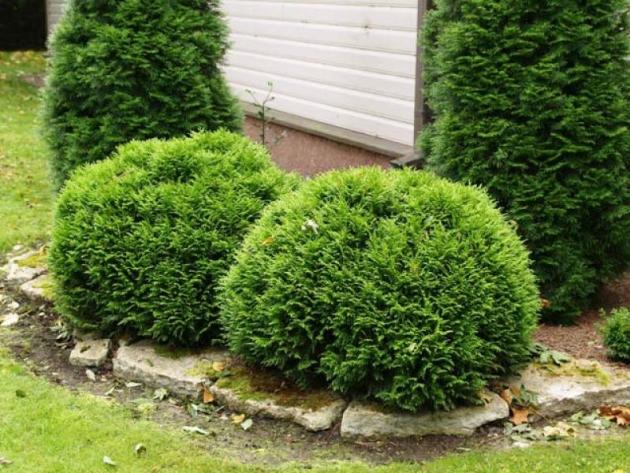
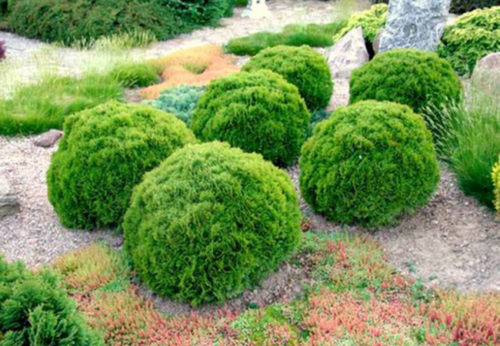
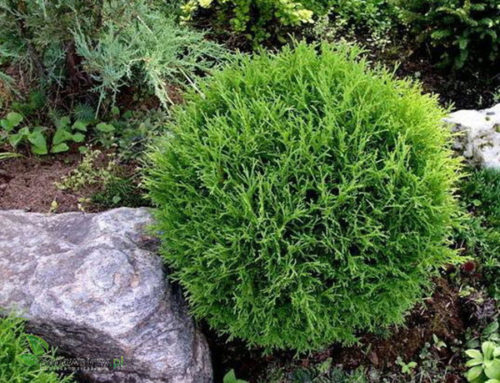
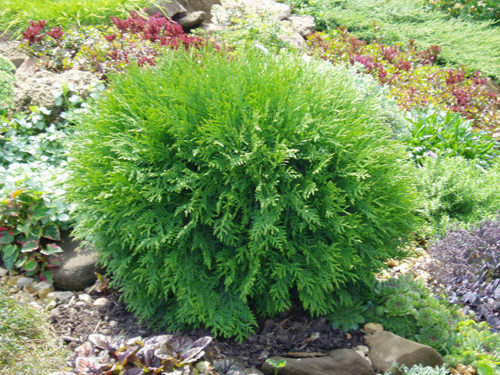
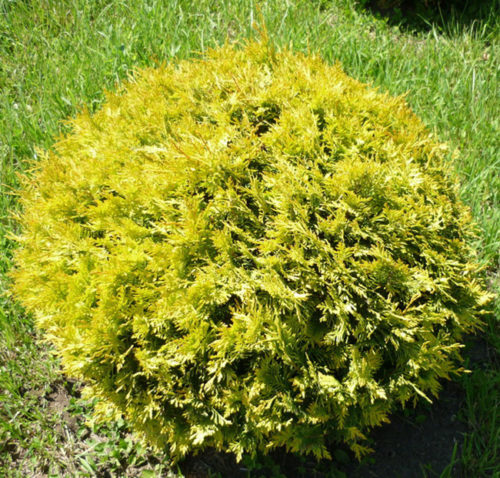
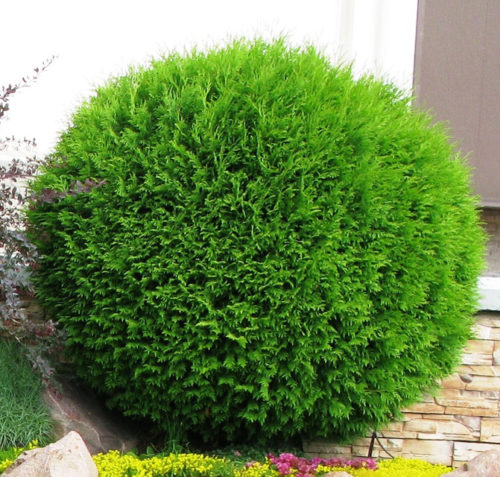
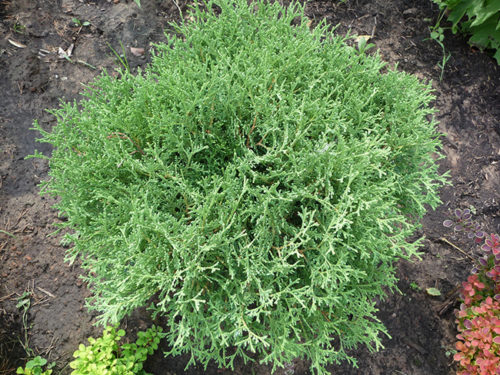
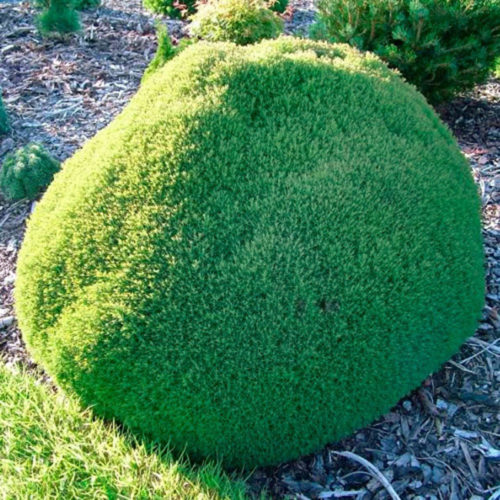
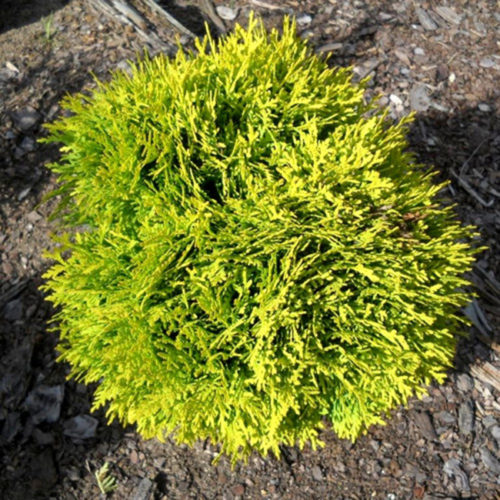
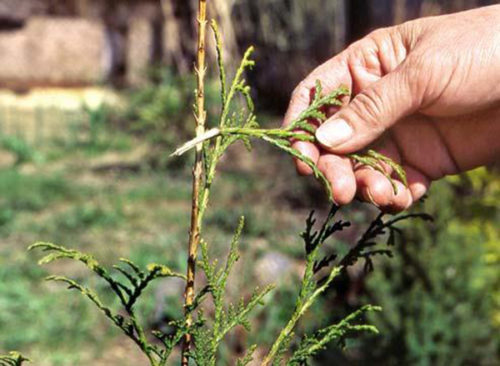
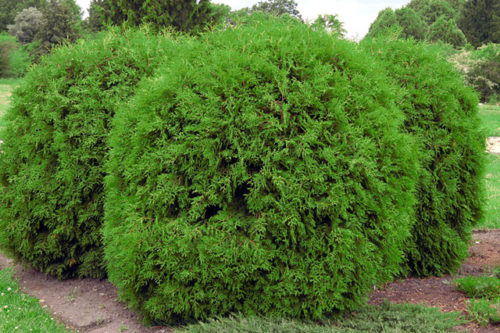
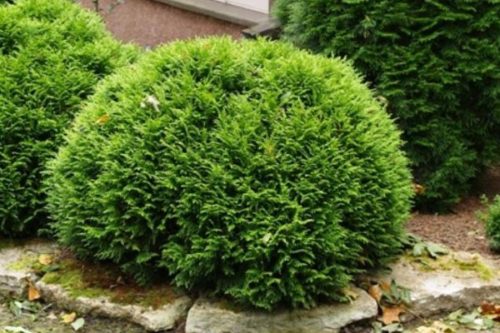
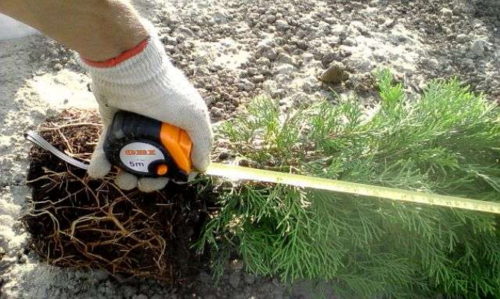
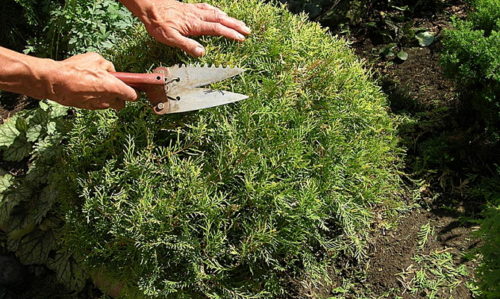
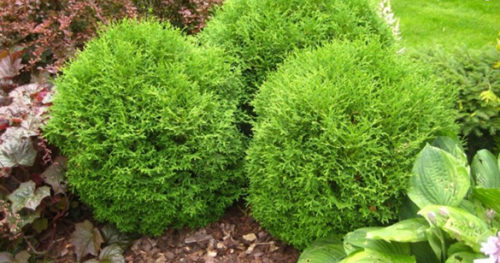
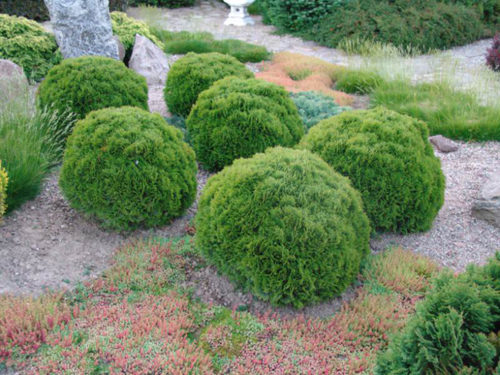
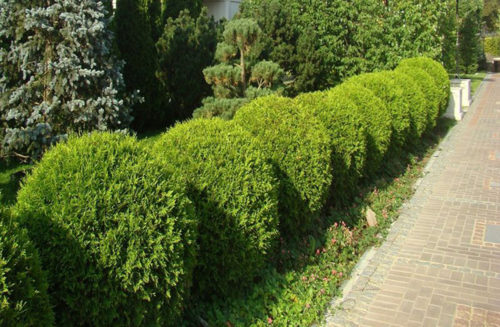
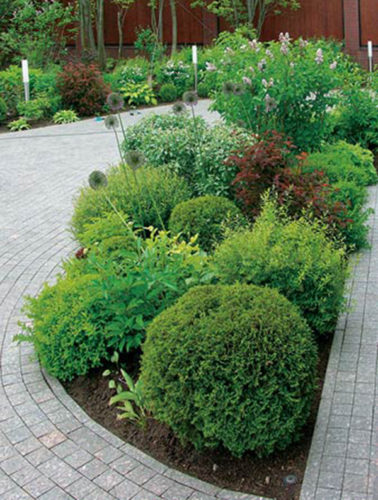

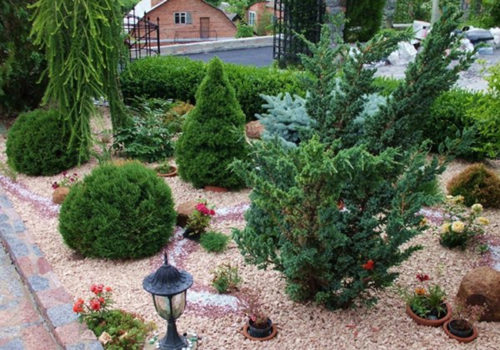












 Start a discussion ...
Start a discussion ...